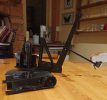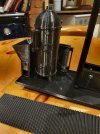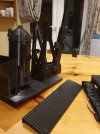You are using an out of date browser. It may not display this or other websites correctly.
You should upgrade or use an alternative browser.
You should upgrade or use an alternative browser.
Motorised steam shovel
- Thread starter DGE-Railroad
- Start date
DGE-Railroad
The Orchard Line
It has... There's something pleasing about looking at the shape too  It printed without supports as the overhang is very gradual
It printed without supports as the overhang is very gradual
DGE-Railroad
The Orchard Line
I need to learn how to paint/weather 3d prints properly now. I suspect the key is in the sanding prep work...
On of things the things I keep thinking I must try is spraying a dullcoat straight over the top, to loose the sheen and see how the filament colour changes
On of things the things I keep thinking I must try is spraying a dullcoat straight over the top, to loose the sheen and see how the filament colour changes
Rhinochugger
Retired Oik
Have you tried etching primer?I need to learn how to paint/weather 3d prints properly now. I suspect the key is in the sanding prep work...
On of things the things I keep thinking I must try is spraying a dullcoat straight over the top, to loose the sheen and see how the filament colour changes
Tain't cheap, but I've used it on many surfaces - it's meant to etch metal of course
DGE-Railroad
The Orchard Line
I'll give it a try.Have you tried etching primer?
Tain't cheap, but I've used it on many surfaces - it's meant to etch metal of course
I'd imagine filler primer works quite well at hiding some of the smaller layer artifacts but with the inevitable risk to details.
I feel a period of YouTube studying and experimentation needs putting in the diary, to narrow down the best approach
Rhinochugger
Retired Oik
well, there are two different aspects - and I'm only an observer, I haven't painted a 3D item.I'll give it a try.
I'd imagine filler primer works quite well at hiding some of the smaller layer artifacts but with the inevitable risk to details.
I feel a period of YouTube studying and experimentation needs putting in the diary, to narrow down the best approach
One is getting the surface flat after the printing; the other is getting paint to adhere.
Etching primer won't help with the first issue, only the second
Having said that, your finished surfaces look pretty good - I mean, you're exposing any imperfections by some very close-up photography
maxi-model
UK/US/ROW steam narrow gauge railways 1:1
Abrade the surfaces of the 3D printed components lightly with some wet & dry. Then apply filler or high build primer. You will need several coats to overcome the stratification lines on the printed part. Yes, if you have fine detail there is a risk you will obliterate it with this method but that is deal with 3D prints - quick to print low res' and low cost or slow to print and more expensive materials for high res'. There is another method using a solvent to "melt" the stratification lines. Solvent used is dependent on material. Do not try heat. I cannot recommend etch primers on plastic, use a specific plastic primer first then overcoat with the filler primer. Max
Rhinochugger
Retired Oik
Yes, I can understand that - I fell into the habit of using it on any and every type of surface.I cannot recommend etch primers on plastic,
It hasn't let me down yet ................
musket the dog
Registered
It's looking really impressive already, I'm sure it will be a lot of fun when it is finished. I've been trying to plan out a steam crane build, I think I might be able to repurpose a few of the bits for that, suitably rescaled.
I can also vouch for Halfords' filler and plain primers. I would usually give the raw print a good sanding first to remove any defects or high spots. Then fill in the printing striations with the filler primer. Definitely a lot easier than trying to sand the plastic back to flat
I can also vouch for Halfords' filler and plain primers. I would usually give the raw print a good sanding first to remove any defects or high spots. Then fill in the printing striations with the filler primer. Definitely a lot easier than trying to sand the plastic back to flat




